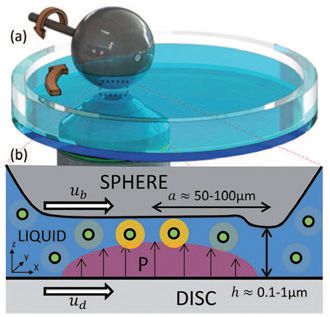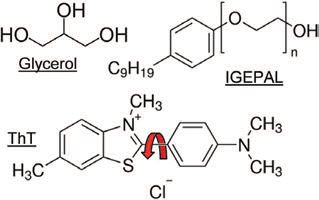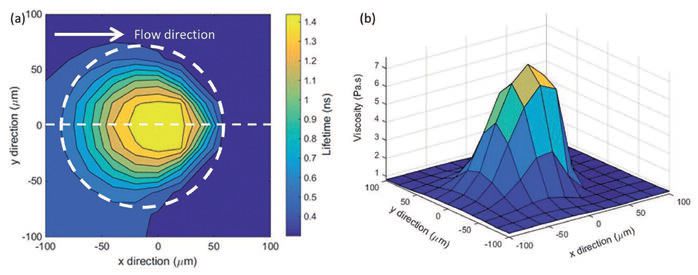Looking at lube in a new light
Drs. Wilfred T. Tysoe & Nicholas D. Spencer | TLT Cutting Edge April 2016
A fluorescence-lifetime-based approach allows viscosity measurements in situ in a lubricated contact.
VISCOSITY IS A CRUCIAL PARAMETER IN FLUID-BASED LUBRICATION, and yet it is a problematic quantity since, in the case of oils, it often changes with shear rate and always changes drastically with pressure. The way in which it does so has been the subject of a number of theoretical approaches, which have not been without controversy (
1). However, actually measuring the viscosity in a lubricated contact or indeed in a rheometer at lubrication-relevant pressures and shear rates has not been possible. Ideally it would be very interesting for tribologists to know more than just a single value of the viscosity in the contact but also the way in which it varies from the inlet to the outlet.
Janet Wong and her colleagues at Imperial College, London, UK, have come up with an
in situ approach to measuring viscosity that relies on the properties of certain fluorescent dyes (
2) known as molecular rotors. Fluorescence occurs when a molecule is excited into a higher-energy state by absorbing light, usually in the visible or ultraviolet region of the spectrum. The excited molecule can then undergo internal relaxations to subsequently emit light at a lower frequency and thus with a different color. The frequency of the emitted light is characteristic of the molecule, but the time for the molecule to relax can be influenced by its environment.
Wong’s group took advantage of this latter property since molecular rotors have two component parts that can rotate relative to each other about a shared bond (
see Figure 1). Any constraints put on this rotation (such as local viscosity) will affect the molecule’s fluorescence intensity and lifetime. In this initial study, the group from Imperial College used a ball-on-disc setup (glass, steel or WC against glass or sapphire). The apparatus was placed on an inverted fluorescence microscope, incorporating a 400-nm laser source to excite the fluorescence. Thioflavin T (ThT) was selected as a molecular rotor, and glycerol and IGEPAL (
see Figure 2) were chosen as examples of Newtonian and shear-thinning liquids, respectively. Fluorescence lifetime was measured, rather than intensity, since it is independent of the film thickness. In a separate, static, pressure-dependent calibration experiment, the fluorescence lifetime could be correlated with viscosity.
 Figure 1. Liquid confined within a sphere-on-flat contact. A molecular rotor, thioflavin T, whose fluorescence behavior (represented by halo) depends on viscosity, has been added to the lubricant (2). (Published by The Royal Society of Chemistry.)
Figure 1. Liquid confined within a sphere-on-flat contact. A molecular rotor, thioflavin T, whose fluorescence behavior (represented by halo) depends on viscosity, has been added to the lubricant (2). (Published by The Royal Society of Chemistry.)
 Figure 2. Chemical structures of the fluids and the dye used in the study (2). (Published by The Royal Society of Chemistry.)
Figure 2. Chemical structures of the fluids and the dye used in the study (2). (Published by The Royal Society of Chemistry.)
The results from this innovative setup are fascinating (
see Figure 3). For glycerol the ThT lifetime, and therefore viscosity, increases as the fluid is drawn into the contact, dropping as it leaves. The circular symmetry corresponds to the Hertzian pressure distribution. While the glycerol experiments showed constant viscosity behavior over a range of tested shear rates, IGEPAL displayed shear thinning, in that the ThT lifetime was observed to drop, as shear rate was increased (up to 5 x 10
5 s
-1).
 Figure 3. Thioflavin T lifetime measurements and corresponding viscosity distribution in a point contact (max pressure = 530 MPa, rolling speed = 74 mm.s-1, film thickness, measured by interferometry = 170 nm), lubricated by glycerol. Dashed white circle is contact area (diameter = 150 µm) (2). (Published by The Royal Society of Chemistry.)
Figure 3. Thioflavin T lifetime measurements and corresponding viscosity distribution in a point contact (max pressure = 530 MPa, rolling speed = 74 mm.s-1, film thickness, measured by interferometry = 170 nm), lubricated by glycerol. Dashed white circle is contact area (diameter = 150 µm) (2). (Published by The Royal Society of Chemistry.)
This approach is innovative and potentially very significant. By judiciously choosing the molecular rotor structure, a very wide range of viscosities can be probed in a variety of fluids. Hopefully the new experimental data obtained in this way will facilitate the testing of models for viscosity variation in contacts and ultimately facilitate the optimization of lubricants and tribological systems for energy saving.
REFERENCES
1.
Spikes, H.A. and Zhang, J. (2014), “History, origins and prediction of elastohydrodynamic friction,”
Trib. Lett.,
56, pp. 1–25.
2.
Ponjavic, A., Dench, J., Morgan, N. and Wong, J.S.S. (2015), “In situ viscosity measurement of confined liquids,”
RSC Advances,
5, pp. 99585-99593.
 Eddy Tysoe (left) is a Distinguished Professor of Physical Chemistry at the University of Wisconsin-Milwaukee. You can reach him at wtt@uwm.edu
Eddy Tysoe (left) is a Distinguished Professor of Physical Chemistry at the University of Wisconsin-Milwaukee. You can reach him at wtt@uwm.edu.
Nic Spencer (right) is professor of surface science and technology at the ETH Zurich, Switzerland. You can reach him at nspencer@ethz.ch.
Both serve as editors-in-chief of STLE-affiliated Tribology Letters journal.